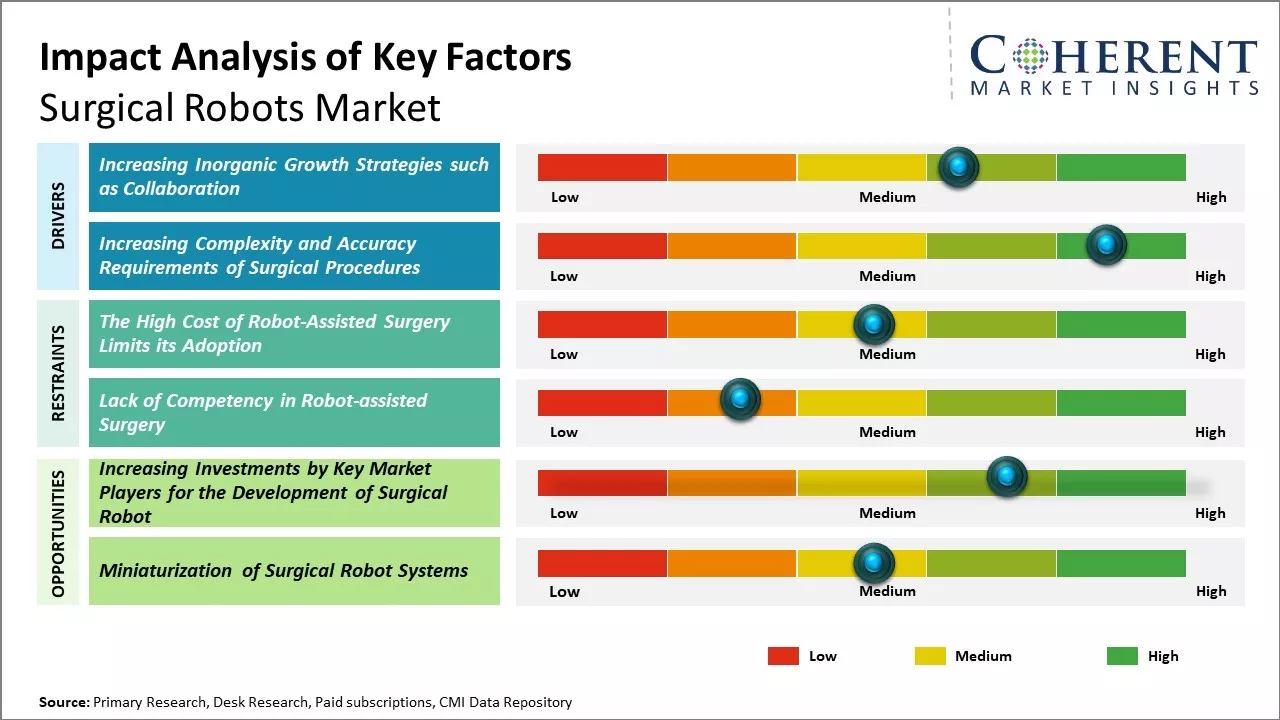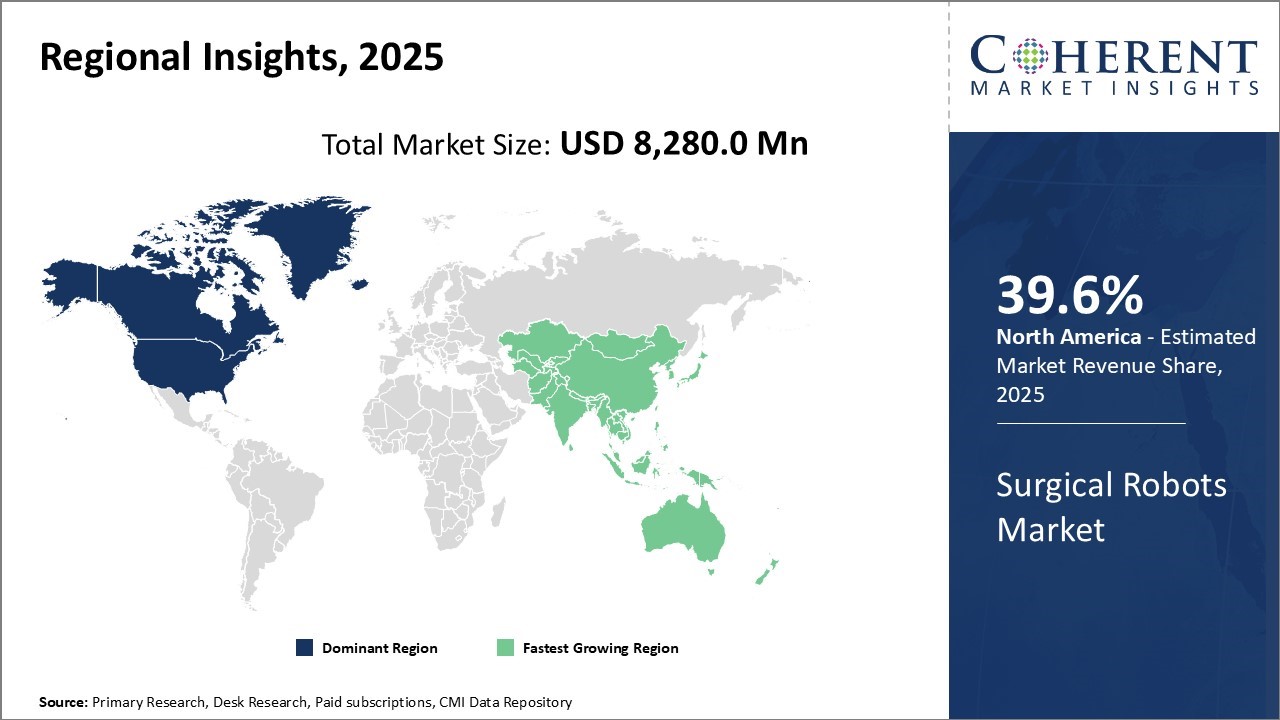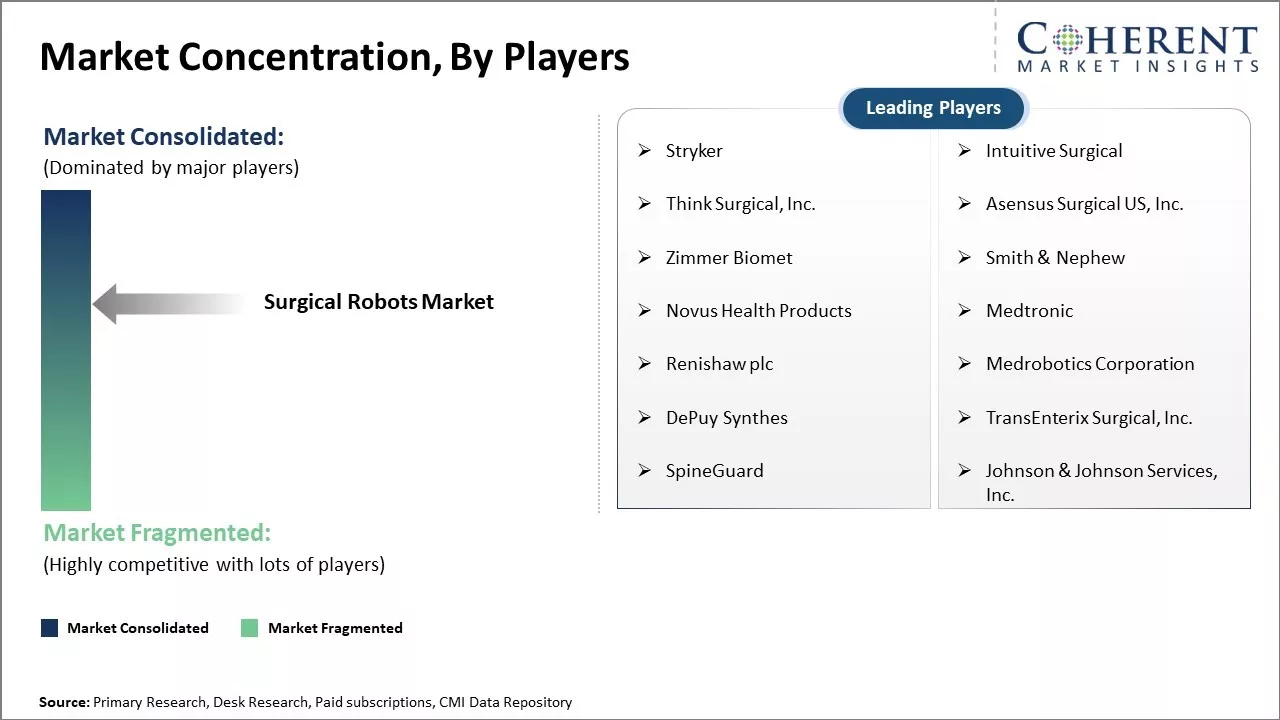The surgical robots market is estimated to be valued at USD 8,280.0 Mn in 2025 and is expected to reach USD 20,604.6 Mn by 2032, exhibiting a compound annual growth rate (CAGR) of 13.9% from 2025 to 2032.

To learn more about this report, Download Free Sample
Surgical robots offer several advantages over traditional open surgeries such as smaller incisions, fewer complications, less pain and blood loss, quicker recovery time and improved surgical outcomes. Their rising uptake in various procedures like gynecology, urology, orthopedic and neurosurgeries will support adoption. Similarly, increasing healthcare expenditure in developing nations creates new opportunities.
|
Current Event |
Description and its Impact |
|
AI Integration and Machine Learning Advancements in Healthcare Technology |
|
|
European Medical Device Regulation (MDR) Implementation and Compliance |
|
Uncover macros and micros vetted on 75+ parameters: Get instant access to report
The convergence of artificial intelligence and robotics is revolutionizing modern surgery, transforming precision medicine and patient outcomes. As healthcare systems worldwide embrace digital transformation, AI-powered surgical robots are emerging as game-changing technologies that enhance surgical precision, reduce complications, and accelerate recovery times.
For instance, in March 2025, Olympus Corp. launched its first AI-powered clinical decision tool through a strategic partnership with software firm, Ziosoft.
Increasing adoption of inorganic growth strategies, such as collaboration, among key market players is expected to drive the market growth over the forecast period. For instance, in February 2025, THINK Surgical, Inc., an innovator in the field of orthopedic surgical robots, announced that it will enter into a new collaboration agreement with b-ONE Ortho Corporation, an original equipment manufacturer (OEM) as well a developer & marketer.
Through this collaboration, THINK Surgical will add b-ONE Ortho implants, including the MOBIO Total Knee System, to THINK Surgical's ID-HUB, a proprietary data bank of implant modules for use with its TMINI Miniature Robotic System.
Advancements in medical science and technology have allowed doctors to perform increasingly complex surgeries to treat conditions that were previously considered inoperable or untreatable. Procedures such as deep brain stimulation for neurological disorders, minimally invasive surgery to repair heart valves, organ transplantation, and cancer surgeries often require tremendous precision, control and endurance from surgeons.
Some robots provide ten-fold magnifications of the surgical area on high-definition screens, integrate pre-operative scans, and allow surgeons to practice interventions through simulations. This enhances spatial understanding and procedural planning. The growing preference for minimally invasive approaches also drives the demand as robotic systems enable procedures through small incisions instead of open surgeries.
The product type segment includes instruments & accessories and robotic systems. The robotic systems sub-segment is estimated to hold 66.4% of the market share in 2025. Robotic systems enable sophisticated procedures through small incisions using advanced computer interfaces and miniature surgical equipments. Constant upgrades to robotic systems allow surgeons to perform an ever-expanding range of minimally invasive surgeries.
Leading manufacturers are developing new system models with improved robot arms, endoscope cameras, and surgical tools. The latest systems offer surgeons enhanced control, visualization, precision, and flexibility compared to older models. Advancements like 3D high-definition cameras and new instrument types enable procedures that were not previously possible robotically.
For instance, in October 2025, Remedy Robotics unveiled remotely operable endovascular robotic platform: the Remedy N1 system.
The surgery segment includes gynecology surgery, general surgery, urology surgery, cardiovascular surgery, neurosurgery surgery, orthopedic surgery, and others. The cardiovascular surgery sub-segment is estimated to hold 38.9% of the market share in 2025. Within the broad field of surgical robotics, cardiovascular procedures have pioneered adoption of the technology.
Several key factors have driven cardiovascular surgery's prominence. Robotic systems are extremely well-suited to the exacting technical demands of cardio procedures. Their precision motion scaling, 3D visualization, and wristed instrument controls allow complex anastomoses and other delicate tasks to be performed via minimally invasive approach. This translates to reduced recovery times, lengths of stay, and complication risks for patients undergoing cardiac surgery.
For instance, in October 2023, SS Innovations International, Inc. introduced an innovative robotic cardiac surgery program in India utilizing its flagship SSi Mantra surgical robotic system. Such instances are propelling the surgical robotics market demand.

To learn more about this report, Download Free Sample
North America remains the dominant region in the global surgical robots market and is estimated to hold 39.6% of the market share in 2025 due to a strong presence of key industry players and early adoption of robotic technologies among healthcare facilities.
The U.S. Food and Drug Administration (FDA) has approved the use of robotic surgical systems for a wide range of procedures, which has propelled their uptake across hospitals. Furthermore, increased healthcare spending along with supportive regulatory environment have boosted installations of surgical robots over the years in the region.
The Asia Pacific region, on the other hand, is poised to be the fastest growing surgical robotics market owing to increasing healthcare investments and rapidly developing healthcare infrastructure. Countries like China, India, Japan, and South Korea are at the forefront and are witnessing growth that is well above global averages. With growing income levels, patients in the region are opting for advanced treatments including robotic surgeries. Local manufacturers are also developing low-cost robotic systems and collaborating with multinational companies to gain foothold.
For instance, in October 2025, MicroPort® MedBot™ announced that cumulative global commercial orders for its Toumai® Endoscopic Surgical Robot have reached 100 units, with nearly 80 installations completed to date. This positions Toumai® as the leading Chinese-developed endoscopic surgical robot and marks a historic breakthrough in the global commercialization of Chinese surgical robotics.
The U.S. is considered as dominating countries in the global surgical robots market in 2025, due to its advanced healthcare infrastructure, early adoption of innovative medical technologies, and high healthcare expenditure. The strong presence of leading surgical robot manufacturers, such as Intuitive Surgical and Medtronic, further supports market growth.
For instance, in September 2023, US Medical Innovations (USMI) and the Jerome Canady Research Institute for Advanced and Biological Technological Sciences (JCRI-ABTS) unveiled new Canady Robotic AI Surgical System.
China is considered as dominating countries in the global surgical robots market in 2025, owing to strong government support, rapid technological advancements, and growing domestic demand for minimally invasive surgeries. Strategic policy initiatives, such as those in the national Five-Year Plans, have fueled investment in medical robotics, while Chinese companies are increasingly developing cost-effective and competitive surgical robot systems.
For instance, in March 2025, MicroPort® MedBot™ announced that its Toumai® SP Laparoscopic Surgical Robot has received market approval from the National Medical Products Administration (NMPA) in China. This groundbreaking surgical robot is approved for clinical use across a variety of departments, including urology, general surgery, and gynecology

To learn more about this report, Download Free Sample
| Report Coverage | Details | ||
|---|---|---|---|
| Base Year: | 2024 | Market Size in 2025: | USD 8,280.0 Mn |
| Historical Data for: | 2020 To 2024 | Forecast Period: | 2025 To 2032 |
| Forecast Period 2025 to 2032 CAGR: | 13.9% | 2032 Value Projection: | USD 20,604.6 Mn |
| Geographies covered: |
|
||
| Segments covered: |
|
||
| Companies covered: |
Stryker, Intuitive Surgical, Think Surgical, Inc., Asensus Surgical US, Inc., Zimmer Biomet, Smith & Nephew, Novus Health Products, Medtronic, Renishaw plc, Medrobotics Corporation, DePuy Synthes, TransEnterix Surgical, Inc., SpineGuard, and Johnson & Johnson Services, Inc. |
||
| Growth Drivers: |
|
||
| Restraints & Challenges: |
|
||
Uncover macros and micros vetted on 75+ parameters: Get instant access to report
Increasing adoption of inorganic growth strategies such as investments by key market players for the development of surgical robot offers lucrative opportunities in the global surgical robots market. For instance, in September 2023, CMR Surgical, UK-based surgical robotics company, announced that they had raised over US$ 165 mn in funding to continue the development of its Versius surgical robot. This latest investment brings their total raised to over $ 1 bn
*Definition: Surgical robots consist of a camera arm and mechanical arms with surgical instruments, which are controlled by surgeons on computer console that offers high definition and magnified 3-D view of the surgical site. Surgical robots aid in performing various complex surgical procedures with more flexibility, precision, and control than conventional surgical procedures.
Share
Share
About Author
Manisha Vibhute is a consultant with over 5 years of experience in market research and consulting. With a strong understanding of market dynamics, Manisha assists clients in developing effective market access strategies. She helps medical device companies navigate pricing, reimbursement, and regulatory pathways to ensure successful product launches.
Missing comfort of reading report in your local language? Find your preferred language :
Transform your Strategy with Exclusive Trending Reports :
Frequently Asked Questions
Joining thousands of companies around the world committed to making the Excellent Business Solutions.
View All Our Clients